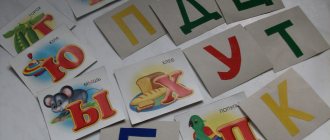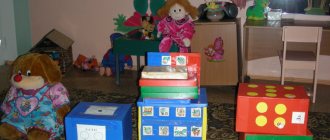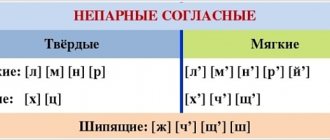3.9
Average rating: 3.9
Total ratings received: 349.
3.9
Average rating: 3.9
Total ratings received: 349.
It is no coincidence that hissing consonant sounds received such an interesting name: they really seem to hiss, since they are pronounced in a special way. Our article for 2nd grade students talks about them in detail: what groups such sounds are divided into, what features and phonetic characteristics they have.
The material was prepared jointly with a teacher of the highest category, Kuchmina Nadezhda Vladimirovna.
Experience as a teacher of Russian language and literature - 27 years.
Letter and sound composition of the language
The conventional sequence of letters in a language, forming a system of written signs, is called the alphabet. Each letter in a word corresponds to a sound element (elements), which makes it possible, in principle, to record speech in writing and reproduce it when reading.
The Russian language has an alphabet consisting of 33 letters.
The Russian alphabetic symbol system is presented in the table below:
| A a | B bae | In ve | G ge | D de | Her _ | Her _ | Zhe _ | Z ze |
| And and | Y and short | Kka _ | L el | M um | N en | Oh oh | P pe | R er |
| With es | T te | U y | F eff | X ha | Ts tseh | Why _ | Sh sha | Shcha _ |
| b is a hard sign | s s | b soft sign | Uh uh | Yu Yu | I I | |||
Number of letters
Voiced and unvoiced, consonants and vowels, hissing letters are included in the Russian linguistic sign system. The widest and most basic grouping of letters is the division into consonants and vowels. Russian belongs to the group of languages of the consonantal type, that is, consonant written characters predominate in it.
The quantitative ratio of letters in the Russian language is as follows: 10 vowels, 21 consonants and 2 letters that do not belong to these categories (ь, ъ).
Number of sounds
The sound composition differs from the alphabetic one by 9 elements in a larger direction; in the Russian language there are 42 sounds.
Voiced and unvoiced, consonants and vowels, hissing letters - these are what the Russian language system consists of
Reasons for the discrepancy between the sound and letter composition of the language:
- The breakdown of the letters i, yu, e, ё into 2 sound elements, one of which is a consonant sound [j'].
- Lack of sound appearance in the letters ъ and ь.
- Adding paired consonant sounds based on softness.
The general quantitative ratio of letters and sounds of the Russian language is presented in the table below:
| Sounds | Number of sounds | Number of letters |
| Vowels | 6 | 10 |
| Consonants | 36 | 21 |
| +ъ and ь, which do not indicate any sound | ||
| Total | 42 | 33 |
Consonant sounds are usually divided according to the following criteria:
- Hard/soft/unpaired in hardness/softness.
- Voiced/voiceless/unpaired in sonority/voicelessness (sonorant).
- Hissing.
The meaning of the letters i, yu, e, ё
The letters i, yu, e, ё are of particular importance for Russian graphics.
Depending on their specific position in a word, they can perform different functions:
- Denote 1 vowel sound ([a], [u], [e], [o]) and the softness of the preceding consonant. This function is typical when the indicated letters follow immediately after a consonant. Examples: crush [m'at'], hatch [l'uk], ice [l'ot], day [d'en'].
- Denote 2 sound elements: consonant [j'] + vowels [a], [y], [e], [o]:
i = [j'a]
yu = [j'у]
e = [j'e]
е = [j'о].
These letters can play this role in the following positions:
- At the absolute beginning of the word. Examples: fair [j'armarka], fir tree [j'olka], spinning top [j'ula], spruce [j'el'].
- After another vowel. Examples: button accordion [baj'an], comfort [уj'ut], chewing [zhuj'ot].
- After ь and ъ, which perform a separating function. Examples: family [s'im'j'a], drinking [p'j'ot], sewing [shj'ut].
The meaning of the letters ъ, ь
The discrepancy in the number of letters and sounds in the Russian language is also explained by the special purpose of the letters ь (soft sign) and ъ (hard sign). Initially, these graphic symbols played a very specific role in the language: they indicated in writing speech sounds that were subject to reduction (they were not pronounced clearly enough).
Over the course of certain historical processes, the letters ъ and ь lost this function and ceased to denote any sounds at all.
At the present stage of language development, the meaning of these letters is limited to several service functions:
- Mitigation . This function only applies to b (soft sign). It softens any consonants (except for sibilants) in the middle, as well as at the end of a word (examples: I'll take, it's a pity, salt, zero letter, palm tree). The soft sign also indicates the softness of the sonorant consonant sound [l] before any other consonants (examples: sick, boy, soapbox).
- Separation . Hard and soft signs play a dividing role in a word. Thanks to this function, the letters ь and ъ do not merge other sounds when reading, and the reader can absolutely accurately reproduce the word in spoken speech. Examples: entrance, adjutant, bunk, monkey, senor. The presence of separating marks, as a rule, signals the presence of a double vowel (я, ё, е, ю).
The difference between letters and sounds
Voiced and unvoiced, consonants and vowels, hissing letters correspond to the sounds in the language. But the concepts of “sound” and “letter” must not be confused. A letter is nothing more than an image, a picture. It does not have any properties and does not distinguish words, but acts as a descriptive element.
Concept of sound
Sound is the minimal element of speech , which is the result of complex articulatory manipulations. Speech sounds have certain characteristics in terms of speech perception and acoustics. Articulatory, all sounds are divided into 2 large classes - vowels and consonants.
The concept of a letter
A letter is a graphic sign that represents sounds in writing. All letters in the language are divided into vowels and consonants, as well as lowercase and uppercase. Sound-letter relationships in language are ambiguous. Thus, the same letter can represent completely different sounds in a letter (example: milk - [mil˄ko], the letter o represents 3 different sounds).
The opposite situation also occurs, when the same sounding element is depicted in writing with different letters (example: onion - meadow, [bow] - [bow]).
A graphic symbol can simultaneously denote 2 sounds at once (example: yula - [j'ula]), and in other cases none (example: spruce - [j'el']). In the orthographic situation “unpronounceable consonant” the letter does not have any sound correspondence (example: stairs - [l'esn'itsa]).
Differences between letters and sounds
The main differences between letters and sounds are presented in the table below:
| Letter | Sound |
| Visual element (see, read) | Auditory element (hear, pronounce) |
| Designating element | Designated unit |
| They do not have any characteristics, they are divided only into vowels and consonants | They have the following characteristic features: hardness/softness, dullness/voice. There are shock and unstressed ones. |
| Does not determine the choice of speech sound | Determine the choice of letter character |
Dividing sounds and letters into consonants and vowels
Voiced and voiceless, hissing sounds belong to the class of consonants. Vowels constitute a class of elements that is opposite in characteristics.
The difference between vowels and consonants:
- According to the method of articulation: vowels are formed with the participation of the voice, noises are completely absent; the air stream does not encounter any obstacle when pronouncing;
- consonants are formed either only from noises (voiceless), or from noises and voices (voiced and sonorant).
- vowels are determined by tone, they are distinguished by melody and harmony of perception; such an acoustic effect is achieved due to certain vibrations of the vocal cords;
- The main function of vowels is syllabification (the number of syllables is always equal to the number of vowel sounds in a word). Other additional functions are coloration of speech, sound strength, emotional content;
Features of hissing sounds
Sibilants have their own characteristics when pronounced . So, you need to tighten your lips and move them forward a little. They cannot be pronounced with closed lips, unlike some others (for example, M). The tip of the tongue is slightly pressed against the palate with its edges, leaving a small space in the center of the tongue. It is through this that the air passes, creating a hissing sound when pronounced.
Initially, hissing consonants were soft in the Old Russian language. They appeared as a result of the first palatalization, or when the combination of consonants with [gj], ['zj] and other sounds changed.
The initial softness of these sounds determined the fact that in many literary monuments the letters that denoted them were pronounced followed by vowels or “ь” , for example:
- husband;
- nessshi;
- hour;
- comfort, etc.
However, in the process of the formation of linguistic norms and adverbs, [w] and [zh] hardened, but “ch” still remained soft. The hardening of [w] took place around the 14th century. At this time, variants of writing the sounds [w] or [zh] with the letter “s” after them appeared in literary monuments. For example, “Shyshkin” or “hold.”
In modern language, it is traditional to write a soft sign at the end or the letter “and” to indicate the sound [s] in words such as:
- disturb;
- sew;
- fat;
- rye, etc.
Combinations such as soft [schtsch] or [zhj], which were common in antiquity, then lost the explosive element in such combinations in words such as “I’m looking for” or “yeast.”
Vowel sounds and letters
The Russian language has 10 vowel letters and 6 vowel sounds. The sounds of the Russian literary language are dominated by the sounds [and] and [a], this phenomenon is usually called “akanie”, “hiccup”. The main feature of vowel sounds that causes difficulties in spelling is the modification of sound quality (reduction) in a weakened position.
The strong position for a vowel is when the sound is under stress; in other cases, the strength and quality of the sound is weakened. The main function of a vowel sound is the ability to form a syllable and become its peak. In the Russian language system, consonants cannot act as syllabic units.
Spelling of vowels after hissing Zh, Sh, Shch, Ch
Let's find out...
- O after sibilants in stressed syllables
. The letter O is written in stressed syllables if it refers to the ending of a noun. For example: big, key, doctor. Also O is written in stressed syllables if it refers to the suffixes of nouns -ok-, -onok and -onk-. For example: boot, powder, bear, barrel, girl, dog. The letter O is also written in adjective suffixes -ov-. For example: penny, walrus. The letter O is used if it is a suffix of adverbs -o-. For example: hot, good. The letter O is written in the -on endings of nouns in the genitive case and plural. For example: princes, intestines. In addition to all this, there are also vocabulary words: gooseberry, glutton, pulp, rattle, slum, thicket, prim, clink glasses, Pechora, seam, rustle, seams, heartburn, burn, arson. In borrowed words, the spelling is similar to the sound. For example: cup, tablet, gesture. - O and E after sibilants in unstressed syllables.
In Russian words, E is written after Zh, Sh, Ch, Shch in unstressed syllables. For example: peas, good. If the word is of foreign origin, then the letter O can be used. For example: jockey, chocolate. - O and E after sibilants in other cases
. In all other cases, the letter E is written, although O can be heard (in stressed syllables). This includes the endings of verbs -eosh, -yot, -yote, eat (for example: you lie, laugh), suffixes of verbs and nouns -yovyva- (for example: chew, shade), suffix of nouns formed from verbs with –yovk (example: delimitation , chewing, uprooting), noun suffix -er- (for example: conductor, boyfriend, trainee), roots with alternating E under stress and E without stress (for example: yellow - yolk, black - blacken, alkali - alkaline), suffixes of passive participles -yonn (-yon) in derivatives from them (for example: baked, carried away, baked, doomed), endings of the pronoun that in the prepositional case (for example: about what, with what).
Share on social networks:
Random article
The concept of transcription
Voiced and unvoiced, consonants and vowels, hissing letters are best displayed in phonetic transcription. The letter fixation of speech does not reflect its sound appearance. The graphic representation of speech is ambiguous in many cases (example: the letter yu can mean 2 sounds or 1).
To accurately convey spoken speech in writing, a transcription method was developed.
Phonetic transcription is designed to convey even the subtle features of sounds due to aspects of acoustics and articulation. Transcription phonetic notation is always enclosed in square brackets. To indicate some sound parameters, additional (diacritical) signs are used, for example, ['] a sign for the softness of a consonant sound.
Phonetic analysis of a lexical unit
Voiced and unvoiced, consonants and vowels, hissing letters must be designated when parsing a lexical unit from a phonetic perspective. Sound analysis of a word is a description of a lexical unit in terms of its letter and sound content, as well as syllabic division.
Step-by-step instructions for phonetic parsing of a lexical unit:
- Write down the required word in the word form in which it is presented.
- Indicate the stressed syllable.
- Divide the unit into syllables.
- Transcribe in square brackets.
- Write down separately, in a vertical column, each sound from the phonetic transcription.
- Characterize each sound written out according to the scheme below:
- vowel: stressed/unstressed;
- consonant:
- voiced/voiceless/sonorant, hard/soft, hissing.
- Count the number of letters in a lexical unit.
- Determine the number of sounds in the analyzed word.
- Correlate the sound-letter composition, indicate inconsistencies, if any.
Voiced and unvoiced, hissing sounds belonging to the class of consonants, as well as vowels, make it possible to record in writing and reproduce the speech flow orally. These units are the basis of the language system.
Article design: E. Chaikina
Working with tongue twisters
Tongue twisters are an excellent warm-up for children , which perfectly develops their speech skills. In the educational process they are used in different ways, in particular, in the study of sibilant consonants.
Invite students to read aloud several tongue twisters in a row. Moreover, the first time this must be done slowly, and then gradually increase the rate of pronunciation.
Ask the children what hissing sounds they found in tongue twisters, whether they differ from each other, and what their main characteristics are.
While taking dictation , offer to write down one of them in your notebook and ask students to underline the hard (or soft) sibilants. Invite one of the students to do this at the board.
Partial written work was mentioned above. It can also include homework. Sometimes workbooks contain tasks where you need to insert missing letters into words that contain certain sibilants. They should be emphasized.
So, we looked at what hissing consonant sounds are, how they can be identified, and with the help of what tasks you can teach a lesson at school on this topic.





